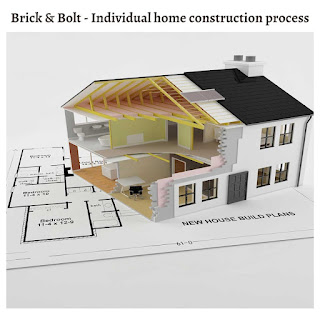Inside Brick & Bolt’s Material Procurement Process: Ensuring Quality at Every Step
When it comes to building a home, quality starts from the ground up, quite literally. Every brick, every tile, and every bag of cement form the foundation of not just a structure, but a future. Brick & Bolt, emphasis on superior material procurement, isn’t just about logistics; it's a commitment to lasting strength, durability, and trust. This blog takes you behind the scenes of how Brick And Bolt ensures high standards during the material procurement process, delivering exceptional quality at every stage of construction.
Why Material Procurement Matters
Home construction is a complex process that relies heavily on the quality of materials used. Even the most innovative design or advanced construction technique can fail if the materials are substandard. Procurement, therefore, becomes a strategic function one that directly impacts safety, longevity, and aesthetics.
The right procurement process guarantees:
- Consistency in quality
- Cost-efficiency without compromising standards
- Timely delivery
- Reduced project delays and rework
Material Procurement Process
Step 1: Defining the Material Requirements
Before any purchase is made, the team collaborates with architects, structural engineers, and project managers to define the exact requirements. Every home has different needs depending on its design, location, and budget. The procurement process begins with a comprehensive Bill of Quantities (BOQ), which lists all required materials from steel and cement to fittings and tiles.
Key considerations at this stage:
Before any purchase is made, the team collaborates with architects, structural engineers, and project managers to define the exact requirements. Every home has different needs depending on its design, location, and budget. The procurement process begins with a comprehensive Bill of Quantities (BOQ), which lists all required materials from steel and cement to fittings and tiles.
Key considerations at this stage:
- Suitability to local climate
- Structural load-bearing requirements
- Fire, water, and pest resistance
- Sustainability and environmental standards
Once requirements are defined, the next critical task is vendor selection. Vendors undergo a stringent evaluation process based on:
Step 3: Sampling and Quality Testing
- Past performance
- Certifications and quality audits
- Product testing history
- Compliance with Indian and international standards
Step 3: Sampling and Quality Testing
Procurement doesn’t rely on documents alone. Samples from vendors are sent for lab testing to check for strength, durability, composition, and other parameters. For example:
Once the materials pass quality checks, the team enters the negotiation phase. The aim is to ensure cost efficiency without compromising quality. This involves:
- Cement is tested for fineness, consistency, compressive strength, and setting time.
- Steel is checked for yield strength, ductility, and corrosion resistance.
- Sand is screened for clay content and particle size.
- Bricks are subjected to water absorption and compressive strength tests.
- Materials that fail to meet quality benchmarks are instantly rejected.
Once the materials pass quality checks, the team enters the negotiation phase. The aim is to ensure cost efficiency without compromising quality. This involves:
- Rate analysis based on market trends
- Bulk purchasing strategies
- Long-term supplier agreements to lock in better prices
Step 5: Issuing Purchase Orders and Real-Time Tracking
A formal Purchase Order (PO) is issued, outlining the material specs, cost, quantity, and delivery schedule. This creates accountability on both sides.
Upon delivery, materials are not immediately used. They are verified on-site through:
Step 7: Inventory Management and Waste Control
A formal Purchase Order (PO) is issued, outlining the material specs, cost, quantity, and delivery schedule. This creates accountability on both sides.
- Procurement teams use advanced digital platforms to:
- Track delivery status
- Monitor stock levels on-site
- Schedule deliveries based on construction phases
- With real-time tracking, delays are reduced, and project timelines are better managed.
Upon delivery, materials are not immediately used. They are verified on-site through:
- Physical inspection for damage
- Quantity checks
- Specification matching
Step 7: Inventory Management and Waste Control
Construction materials must be stored and used carefully to prevent waste. Inventory managers keep detailed logs of:
- Daily usage
- Remaining stock
- Excess consumption
Additionally, proper storage practices (like covering cement bags or stacking bricks correctly) are followed to prevent spoilage and ensure safety.
The Role of Technology in Modern Procurement
Today, material procurement has evolved into a tech-enabled function. Construction firms use:
The Role of Technology in Modern Procurement
Today, material procurement has evolved into a tech-enabled function. Construction firms use:
- Procurement dashboards
- AI-based forecasting tools
- Vendor rating systems
- Automated reorder alerts
Clients also benefit from these platforms as they get visibility into:
- Order status
- Material quality reports
- Budget utilization
- Challenges and Solutions
Material procurement is not without challenges. Common issues include:
Final Thoughts: Quality Starts With Procurement
- Supplier delays
- Market price fluctuations
- Shortages during peak seasons
Final Thoughts: Quality Starts With Procurement
Many people associate construction quality with visible elements: tiles, paint, fittings. But true quality begins much earlier, in the procurement stage. The selection, inspection, and management of raw materials determine the durability, safety, and value of the final structure.
Conclusion
In home construction, excellence isn't accidental; it's engineered through every choice made behind the scenes. The material procurement process is one of those crucial but often overlooked areas where precision and commitment make all the difference. Companies like Brick & Bolt have perfected this system, ensuring every home they build stands strong for generations. With Brick And Bolt, you're not just investing in bricks and beams; you're investing in a process that prioritizes quality from the first purchase order to the final finishing touch.



Comments
Post a Comment